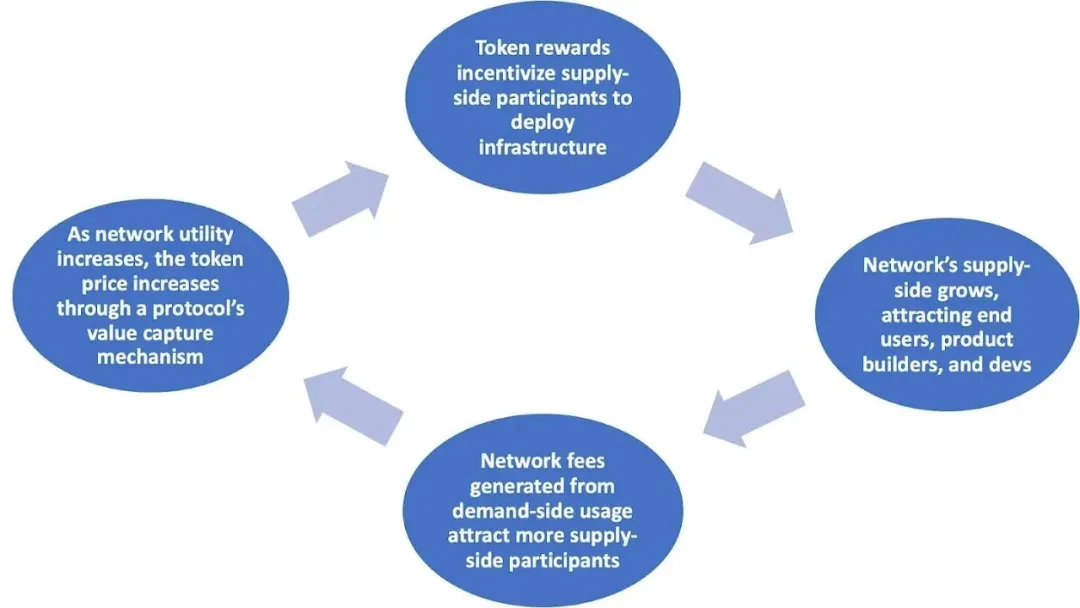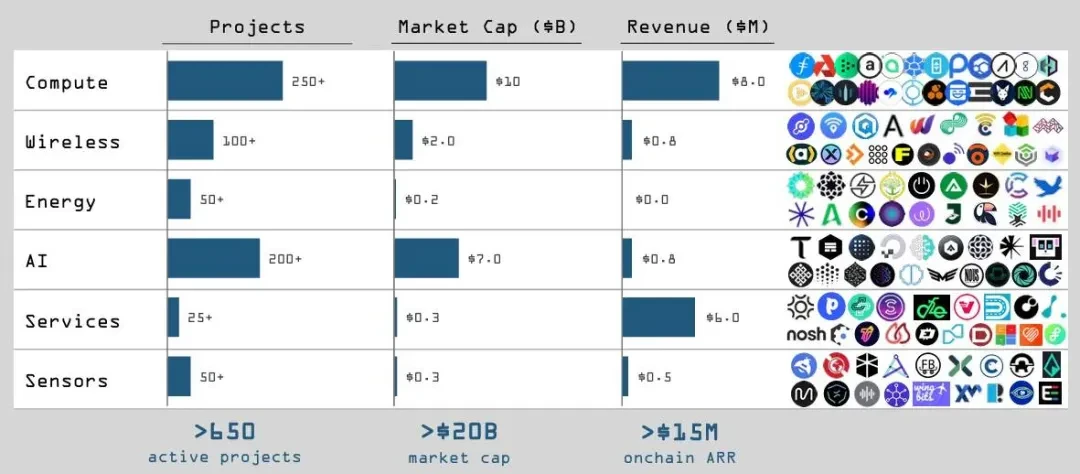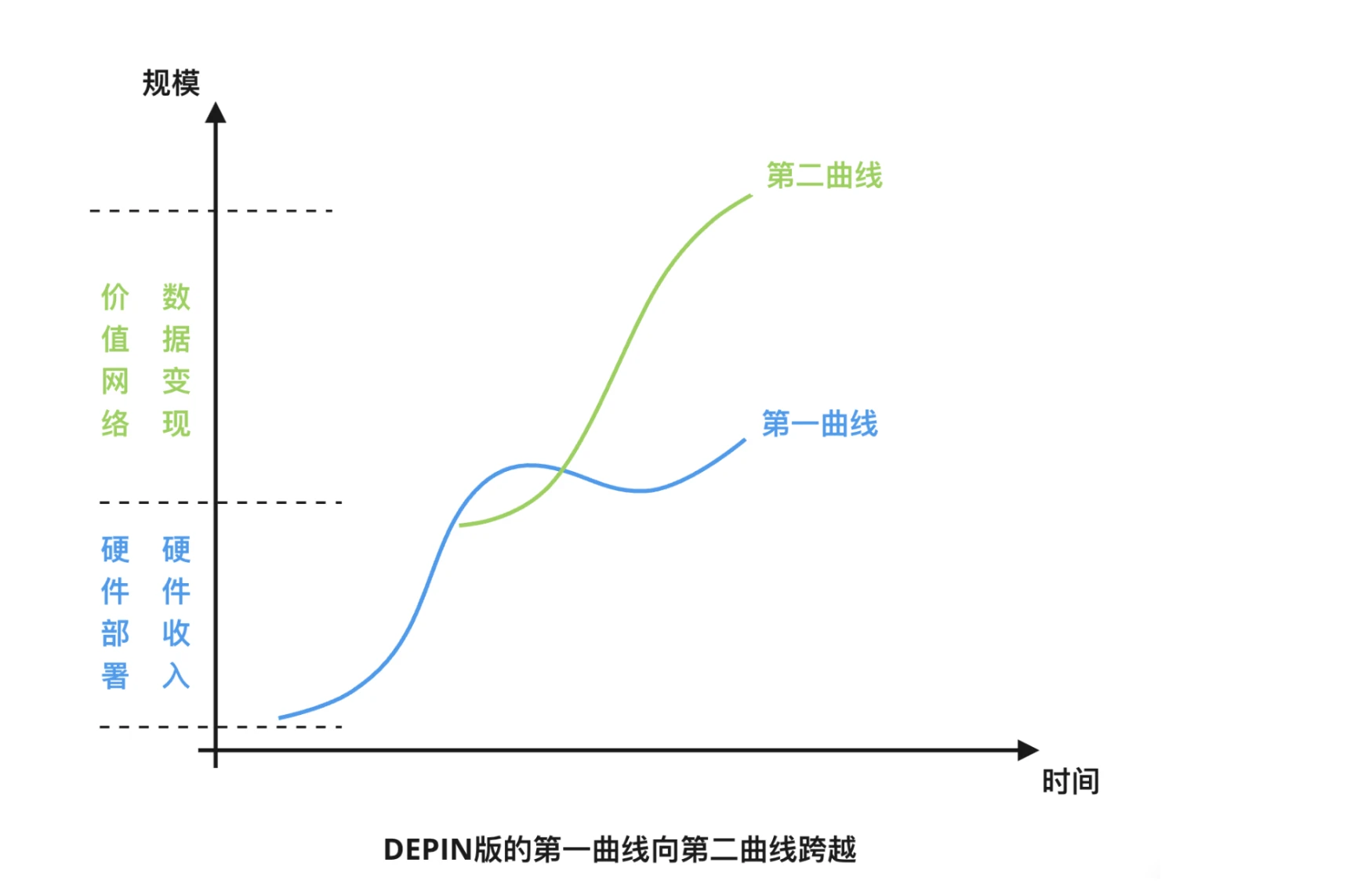DePIN: Aufbau eines dezentralen Wertschöpfungsnetzwerks durch duale Kurven
Hash of this article ( SHA1 ): b 5 be 995 ca 6 de 70 a 97 afdd 995 fe 484 dc 091 b 3 c 2d d
No.: Lianyuan Security Knowledge No.011
DePIN (Decentralized Physical Infrastructure Network) is gradually realizing large-scale interaction between the physical world and Web3, and gradually subverting the operation mode of traditional infrastructure. Through the combination of sensors, wireless networks, computing resources, AI and blockchain technology, By using crypto-economic incentives to promote crowdsourcing development, DePIN is forming a decentralized value network. DePINs business model includes an important feature: hardware revenue is the first growth curve, and data services are superimposed on this basis. The superposition of these two curves is one of the key factors that enable DePIN to lead the growth of the current cycle. It also shows how DePIN projects can create huge wealth in the process of building a decentralized infrastructure network. effect, and ultimately form a large-scale decentralized value network.

This concept foreshadows an application scenario full of imagination: the common infrastructure around us, including communication base stations, car charging piles, photovoltaic panels, billboards, and the data storage and computing equipment behind the operation of the Internet, will no longer be managed by the central government. Instead of being controlled by standardized entities and institutions, it is divided into units of the same size and controlled by individuals or large-scale miners. Physical infrastructure of the same type is highly standardized and scaled, forming a blanket cover.
Through a decentralized approach, the layout and utilization of infrastructure can achieve higher efficiency and lower costs, while enhancing the security and resilience of the overall system. From energy production to data processing, all types of facilities have the potential to move towards a decentralized The above-mentioned DePIN-related industries have a combined market size of more than $5 trillion. Therefore, Messari predicts that the potential market size of the DePIN field is estimated to be about $2.2 trillion, and it is expected to reach $1.3 trillion by 2028. It will reach 3.5 trillion US dollars in 2018.
DePIN Track Division

The DePIN track covers six sub-fields: computing, AI, wireless communications, sensors, energy, and services. From the perspective of the supply chain, DePIN can be divided into:
-
Upstream: hardware manufacturers and supply-side users who are “miners”.
-
Midstream: Project platform, blockchain responsible for data verification and token settlement, and on-chain layer 2 protocol serving DePIN; modular service components for developing and managing the DePIN network (such as platform interface, data analysis and standardization services) ), SDK toolkit and API interface developed by DePIN, etc.
-
Downstream: Connecting with dApp applications and interfaces on the demand side.
Most DePIN projects choose Solana or IoTeX as the settlement layer of the token economy. AI and cloud computing projects in the sub-field focus more on on-chain settlement and project platform development and management. The underlying hardware devices are idle through middleware scheduling. electronic devices such as mobile phones or computers equipped with high-performance consumer-grade GPUs.
DePIN Industry Development Overview
According to DePIN Ninja data, the number of DePIN projects that have been launched has reached 1,215, with a total market value of approximately US$43 billion. Among them, the total market value of projects that have issued tokens and are listed on Coingeckos DePIN sub-section exceeds US$25 billion. , this figure is only 5 billion US dollars, and it has increased fivefold in less than a year, which shows the rapid growth of the DePIN industry. This shows that the market demand and recognition for decentralized physical infrastructure networks are constantly increasing. With more projects With the launch of DePIN and the expansion of application scenarios, the DePIN industry is expected to become an important field for the combination of blockchain technology and real-world applications.
Enlightenment from DePIN business logic
The prototype of DePIN can be traced back to the concept of IoT + Blockchain in the previous cycle. Projects such as Filecoin and Storj use crypto-economic models to transform centralized storage into a decentralized operation model and establish a strong presence in the Web3 ecosystem. It has been put into practical use, such as on-chain NFT storage and front-end and back-end resource storage of DApps.
IoT + blockchain only reflects the characteristics of decentralization (“De”), while DePIN emphasizes the construction of physical infrastructure and large-scale Internet networks. The “PI” in DePIN stands for Physical Infrastructure. ), N stands for network, which is the value network formed after DePIN hardware reaches a certain coverage scale.
The most typical example is Helium. Founded in 2013, Helium did not decide to use blockchain as an incentive for decentralized deployment of the Internet of Things until 2018. So far, Helium has met almost all the elements of DePIN: node economy, Miner model, value network, crowdsourcing incentives, and it is a leading project in the field of DeWi (decentralized wireless communication); in addition, the $20 communication package service launched by Helium Mobile in cooperation with T-Mobile can not only receive token rewards, They can also enjoy reliable communication services, while solving the signal coverage problem in remote areas of the United States, forming a win-win situation for all three parties. Helium and Filecoin both belong to the category of DePIN, but the difference between the two is that Helium emphasizes hardware more, enabling it to Support the growth of second-curve data services through hardware revenue and build an independent ecosystem.
DePINs explosive growth is based on the double curve theory
The Second Curve is a concept in management and innovation theory, originally proposed by management scholar Charles Handy. It refers to when an organization, product or business reaches the peak of its traditional growth curve and needs to Introduce new innovations or changes to start a new growth curve, thereby avoiding stagnation or decline.

Hardware value is the first curve of value creation
In the first growth curve, the business will experience rapid growth in the early stages and then gradually reach its peak. The growth momentum of the first curve of the DePIN project comes from the revenue and profit generated by selling hardware. Traditional infrastructure, especially in data storage In the fields of telecommunication and communication services, the business logic of centralized service providers or entities is linear: in the early stage of the business, it is necessary to invest in infrastructure construction and provide services to end users (C-end) after the infrastructure is improved. Businesses often require the participation of giant companies to bear the high costs in the early stages of business operations.
The DePIN project splits the centralized supply side and crowdsources it to complete the establishment of the hardware network. The DePIN project attracts the participation of supply-side users by promoting itself, transferring the huge infrastructure investment costs to the supply-side users. , achieving low-cost lightweight startup. Supply-side users become shareholders of the project party in the form of holding hardware, and help the project party deploy the hardware network with the expectation of making money from mining in the future.
For example, Hivemapper and Helium have very impressive business performance:
-
Helium: A decentralized wireless network with Helium Hotspot and Helium Mobile as its main businesses. Helium Mobile is a mobile communication service launched in partnership with T-Mobile, which has grown from 0 to 93,000 subscribers in 5 months.
-
Hivemapper: A decentralized mapping platform, whose main business includes HiveMapper Dashcam. This device is priced at $549. Based on the current number of node deployments, Hivemappers revenue from hardware sales alone has reached more than $60 million.
Other projects such as Jambo and OORT have also achieved good growth in hardware revenue. For example, Jambo has achieved outstanding sales in the African market with mobile phones as its selling point; OORT has achieved significant growth in cloud computing and edge computing through its innovative model. of hardware sales revenue.

The realization of data value and network value is the second curve of DePIN growth
After the DePIN project has accumulated a certain amount of income by selling hardware in the early stage, that is, before the first curve of equipment sales growth is about to reach the critical point, the second curve will be started after the business of equipment sales in the early stage reaches the peak. The core of the second curve growth is based on scale. After the hardware network has matured, the data value network will be built on it.
DePIN aggregates a series of value chains, splits the centralized supply side, and uses public chains to aggregate multiple demand sides, ultimately forming a data value network under the DePIN model.
Although the DePIN project emphasizes physical properties, its core business logic revolves around how to obtain value from data. Data passes through the blockchain storage layer.
Abschluss
DePIN achieves efficient deployment and management of physical infrastructure through a decentralized approach, demonstrating huge market potential and room for growth. Despite the challenges in technology, demand, economy, and regulation, DePINs decentralized nature and innovation The business model provides a solid foundation for its future development. The PandaLY team will continue to pay attention to the trend of DePIN and explore it in depth in subsequent posts.
Lianyuan Technology is a company focusing on blockchain security. Our core work includes blockchain security research, on-chain data analysis, and asset and contract vulnerability rescue. We have successfully recovered many stolen digital assets for individuals and institutions. At the same time, we are committed to providing industry organizations with project security analysis reports, on-chain traceability and technical consulting/support services.
Vielen Dank fürs Lesen. Wir werden uns weiterhin auf Inhalte zur Blockchain-Sicherheit konzentrieren und diese teilen.
This article is sourced from the internet: DePIN: Decentralized value network construction driven by dual curves
Blocmates interview original video: https://www.youtube.com/watch?v=Nl1 vGOktoxM 1. Hello, today we have invited Jarindr, the founder of GuildFi. GuildFi has recently upgraded its brand to Zentry, as I think everyone knows. So first of all, please introduce yourself and share your past experience in the crypto field. Hello, Im Jar, the founder of Guildfi, which has recently been upgraded to Zentry. I have an engineering background, and my first job was in the crypto field. I previously focused on the design of crypto expansion solutions, such as the Plasma protocol, which is basically based on the technical level of Layer. I have been working in the crypto industry for about 10 years. Most people probably havent heard of the Plasma protocol, but if youve been in the crypto field long enough,…







